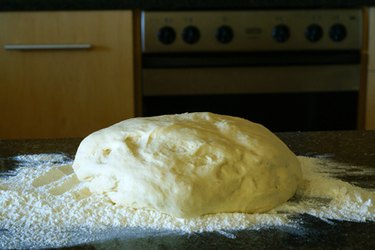
Yeasts are living organisms, specifically fungi, vital to the process of fermentation. They ingest sugar and convert it to carbon dioxide and alcohol. The carbon dioxide is what makes bread rise and beer bubbly. The alcohol is burned off during the baking process which is why baking bread smells so delicious. Although the function of yeast in baking and wine making is the same, they are different types of yeast.
Active Yeast
Video of the Day
Active yeasts are most commonly used for baking. They are widely available in the baking section of your local supermarket and are sold in strips or in amber bottles. Active yeast looks like small granules of sand. Active yeasts are relatively robust and can withstand being held under various conditions, although they do last longer if kept dry and cold.
Video of the Day
Wine Yeasts
There are dozens of wine yeasts available, coming in either a liquid or powdered form. Each yeast ferments a little differently and different yeasts are used for making fruit wines, champagnes and saki because they vary in sugar, alcohol and carbon dioxide content. Advanced winemakers tweak recipes by altering yeast strains. Some wine yeasts are more sensitive to changes in environmental conditions than are active yeasts and must remain refrigerated until use.
Using Yeast
Both active and wine yeasts should be activated before use. Active yeast is activated by stirring it into a cup of warm water at temperatures of 105 to 115 degrees Fahrenheit. Let the active yeast sit for five minutes. If alive and active, the yeast will form a foam at the top of the water. Activating wine yeast is trickier and depends on the type of yeast used. Some yeasts are purchased ready to ''pitch,'' or throw into the wine. Others require slight heating with the addition of other ingredients. When purchasing a wine yeast, follow the activation directions on the package.
Interchangeability
Wine yeasts can tolerate high alcohol levels and can survive in 18 percent alcohol. On the other hand, baking yeast can only survive in alcohol levels up to 14 percent, so using baking yeast in wine making will result in a weakly alcoholic but sweet wine. Many wine yeasts do not do well under high temperatures, and they may be killed during the baking process. It is best to stick with active yeast when baking.